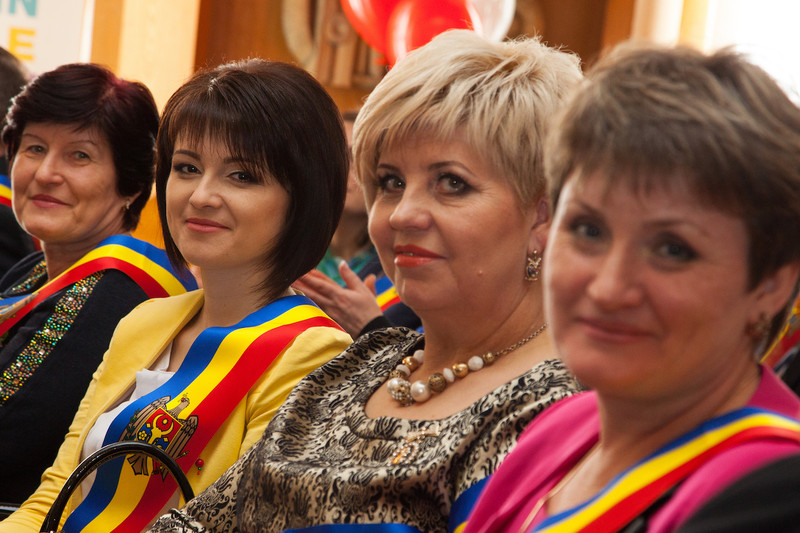[ad_1]
From Estonia to Moldova and from Slovakia to Georgia, the wider region of eastern Europe is increasing its number of female heads of state and prime ministers, seeing more women occupying the highest echelons of national politics.
After Kaja Kallas was sworn in as the country’s first female prime minister earlier this year, Estonia became the first republic in the world where both the head of state and of government are women, and with almost half of new cabinet portfolios held by women.
Also in the Baltic region, Lithuania appointed Ingrida Simonyte as prime minister, becoming the second woman to serve in the role. Women also make up half of country’s 14-strong cabinet.
The Republic of Moldova, which like Estonia and Lithuania gained its independence from the former Soviet Union in the early 1990s, could too be on cusp of having an all-female top leadership.
Maia Sandu made history when she was elected Moldova’s first female head of state at the end of last year. She has now appointed pro-European Natalia Gavriliţă as prime minister, as both try to wrestle with a hostile parliament.
Gavriliţă is in for a far bumpier ride than her Estonian counterpart, after her appointment was rejected by the Moldovan parliament following last Thursday’s (11 February) vote.
Another round of voting will follow but her chances of becoming PM might have dropped significantly.
Moldova’s EU neighbour also recorded a historic moment at the end of last year, when Anca Dragu was voted Romanian Senate speaker.
Romania’s constitution stipulates that the Senate leader is first in line to succeed to the presidential powers and duties in case the head of state becomes incapacitated, impeached or resigns.
A former finance minister, Dragu told EUobserver that her focus in this mandate will be to digitalise the Senate’s work and simplify bureaucratic procedures – but also to promote female leadership in politics.
“It is an honour for me to be the first woman holding this office, and I want to promote and encourage more women to get involved in politics. Also, I will focus on tackling domestic violence and gender inequality still present in the Romanian society”, the Senate speaker told EUobserver.
Despite Dragu being appointed first female leader of the upper house of the Romanian parliament, the country’s gender representation at ministerial level is far less promising, with only one woman entrusted with a portfolio.
Neighbouring Serbia achieved a double-first when Ana Brnabić was appointed the first female and the first openly-gay person to hold the office of prime minister.
Slovakia and Georgia have also elected Zuzana Čaputová and Salome Zurabishvili as their countries first female heads of state.
Meanwhile, women from eastern Europe also hold sway in international institutions such as the World Bank (chaired by Bulgarian Kristalina Georgieva) and the European Commission, where Czech Republic, Croatia, Bulgaria, Romania and Estonia all appointed women for top jobs.
Parliamentary representation
Less glitzy than top executive offices, female political participation in legislative bodies across the region has also increased over the past decade – albeit slowly.

According to World Bank Development Indicators, countries in eastern, central Europe and the Caucasus region have, with few exceptions, seen a rise in the number of seats held by women in national parliaments.
Serbia (38.8 percent) and North Macedonia (38.3 percent) are in the lead, while Croatia (31.1 percent), Ukraine (21 percent), Armenia (23.5 percent) has seen the percentage of female representation doubled over the past five years.
Estonia (28.7 percent) and Lithuania (24 percent) saw a gradual increase while Latvia jumped from 18 percent in 2015 to 30 percent in 2020.
One of the exceptions is the Republic of Moldova which has witnessed a small decline of one percent in the number of women holding seats in parliament.
Yet, that was offset by the 11 percent increase of women now holding ministerial office in Moldova, according to data provided by the National Statistics Office.
At the EU Parliament level, the percentage of women represented has risen since the 2014 elections and now stands at 39.5 percent.
Top performing countries also rank high at national level, with member states like Finland (57.1 percent), Sweden (52.4 percent) and Denmark (50 percent) leading the way, while member states such as Bulgaria (29.4%), Romania (18.2 percent), Cyprus (0 percent), and Slovakia (21.4 percent) perform the poorest.
Curiously, Malta, whose gender-equality record in national politics is near the bottom compared to other EU member states, has gender parity in the European Parliament, with 50 percent of its members being women.
Despite the overall trend of improvement in women’s representation in eastern Europe, the region, in catching up with top-performing EU member states, has to deal with still quite a few hurdles and an overall patriarchal view regarding women’s role in society.
[ad_2]
Source link
